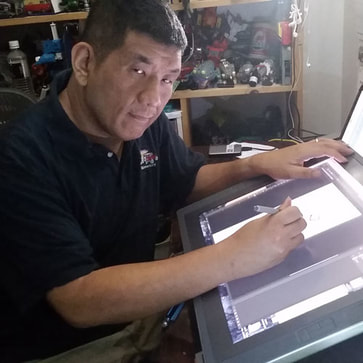Poe Tan demonstration on April 6
by Angela Alvarenga

Poe Tan gave a captivating demonstration on how to maintain form and life in inanimate objects. He started with giving the audience questions to encourage us to think of creative ways to use our tools. How to sketch? How do you use line and pens to make something more dimensional? How do you use your pen to create or suggest texture? Tan reminded us that drawing is not easy and time is needed to master and nurture it. He enjoys working with woodless pencils because it is like painting, and working with pen because it makes you think before you start the drawing. Each line must have a meaning before putting it down on paper.
Tan always starts with basic shapes because everything has a basic shape—visual language can be broken down to basic circles, squares and rectangles. Use different elements to make texture. When creating animals, think about the overall anatomy of the animal, how do you apply basic forms and shapes with the consideration to their real proportions? Study military vehicles and think about how and why they were built in regards to functionality for battle. Planes are cylinders attached to other cylinders, carving out other shapes to make it aerodynamic. These objects all started with simple shapes and form. To create a unique tree, break it down to shapes and values. Create dominant shapes, light areas, and interesting groups of leaves. Try to stay away from symmetry and make it organic. Add volume and choose one source of light in order to then indicate shadows with volume for each shape. Have the lines wrap around the object to create texture and volume. Organize your darks and let them overlap each other. Lastly, go in for the detail on the outer line to solidify the form.
Remember to use perspective when drawing rocks. Start out with your basic rectangle and then sculpt away. Rocks have multiple surfaces and values. Consider the type of rock because different rocks generate different texture. Lastly, use surface values to indicate each side so it does not look flat.
Tan’s demonstration reminds the artist to plan and start with basic shapes. Texture and value will help bring objects to life and make them more interesting. All of these steps take practice but with each drawing you will get better.
Tan always starts with basic shapes because everything has a basic shape—visual language can be broken down to basic circles, squares and rectangles. Use different elements to make texture. When creating animals, think about the overall anatomy of the animal, how do you apply basic forms and shapes with the consideration to their real proportions? Study military vehicles and think about how and why they were built in regards to functionality for battle. Planes are cylinders attached to other cylinders, carving out other shapes to make it aerodynamic. These objects all started with simple shapes and form. To create a unique tree, break it down to shapes and values. Create dominant shapes, light areas, and interesting groups of leaves. Try to stay away from symmetry and make it organic. Add volume and choose one source of light in order to then indicate shadows with volume for each shape. Have the lines wrap around the object to create texture and volume. Organize your darks and let them overlap each other. Lastly, go in for the detail on the outer line to solidify the form.
Remember to use perspective when drawing rocks. Start out with your basic rectangle and then sculpt away. Rocks have multiple surfaces and values. Consider the type of rock because different rocks generate different texture. Lastly, use surface values to indicate each side so it does not look flat.
Tan’s demonstration reminds the artist to plan and start with basic shapes. Texture and value will help bring objects to life and make them more interesting. All of these steps take practice but with each drawing you will get better.
